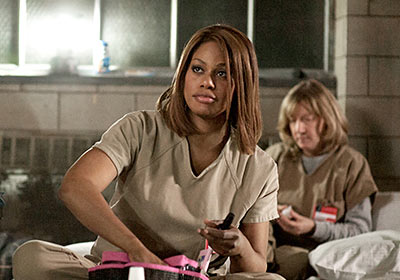Online shows lead the way in LGBT characters

Empire
LGBT media activists have for the first time included streaming services such as Amazon, Hulu, and Netflix in their analysis of LGBT characters on US television.
In its 20th annual Where We Are on TV report, the Gay & Lesbian Alliance Against Defamation (GLAAD) found that there will more transgender characters on these streaming services than on primetime television in the coming year.
The report assesses the LGBT diversity of scripted television series on broadcast and cable networks, and streaming services for the 2015-2016 TV season.
Transgender characters are completely absent from primetime broadcast programming, and only three recurring trans characters were counted on cable (2%), said GLAAD.
Original series on streaming services, however, boast the highest percentage of transgender characters at 7%, with two notably being series leads. However of the seven total trans characters counted, only one was a transgender man.
“The expansion of the television landscape into digital platforms is helping to spark these needed changes, as content creators like Netflix and Amazon are making their mark with groundbreaking series like Sense8 and Transparent,” commented Sarah Kate Ellis, CEO & President of GLAAD.
Of the 881 regular characters expected to appear on broadcast primetime programming in the coming year, 35 (4%) were identified as gay, lesbian, or bisexual. There were an additional 35 recurring LGB characters.

Orange Is the New Black
The number of regular LGBT characters counted on cable increased from 64 to 84, while recurring characters increased from 41 to 58.
Bisexual representations rose on both broadcast and cable this year with a notable increase (from 10 to 18) in the number of bisexual men appearing on cable programs. Unfortunately, many of these characters still fall into dangerous stereotypes about bisexual people, noted GLAAD.
“The critical and commercial success of series like Empire, Transparent, and Orange Is the New Black can serve as an example to network executives that audiences are looking for stories they haven’t seen before,” said Ellis.
“We’ve witnessed tremendous progress in television since GLAAD began tracking the presence of LGBT characters 20 years ago, but there is still a great deal of work to be done and many new and exciting stories to be told.”
I HIGHLY recommend Sense8. The Wachowski’s have really found a place where they can bring their grand sensibilities to life in the form of a series. Epic and authentic in its setting across multiple cities around the world and filled with interesting, complex characters, including an intersection of LGBTI characters against a high concept theme, the story is compelling and heart-filled. It is sci-fi at its core, so may not immediately appeal to all, but it is filled with such soul that one can’t help but be drawn in.